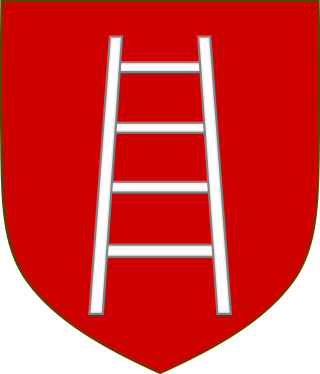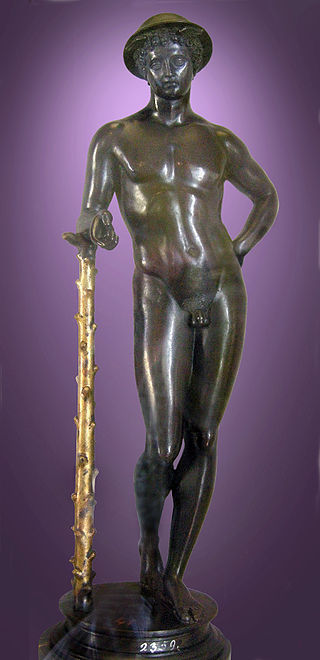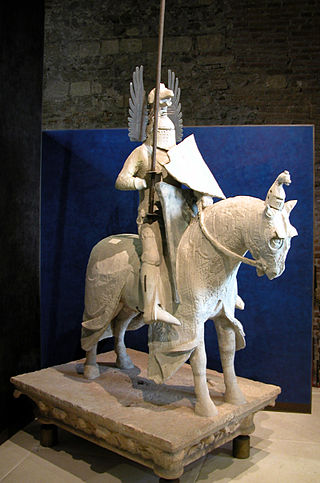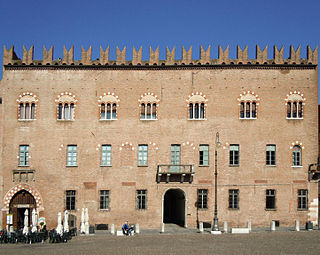History
Pinamonte Bonacolsi was appointed one of two rectors of the commune on 12 July 1272, at first for a period of two months, internal strife among the extended kinship groups of the commune having reached excessive violence and murder. Within a few months Pinamonte was able to accuse and exile his co-rector Federico da Marcaria and the podestà, and gather power into his own hands. A communal reform in 1274 gave him a new position, capitano del popolo, which Pinamonte soon assumed for life. [1] Pinamonte pacified the city by exiling the most troublesome of the families, confiscating their goods, made peace among his neighbors, declared allegiance to the distant Emperor as a Ghibelline city; Mantua entered on a prosperous period.
On 29 September 1291, Pinamonte's son, Bardellone, unseated his father in a coup; putatively, Bardellone was co-governor with his father, but nothing further is heard about the father, who died officially unnoticed, 7 October 1293. Bardellone's brother Tagino was exiled to Ferrara, where he formed lasting ties with the Este. Bardellone replaced the commune's consiglio maggiore with a consiglio del signore, 2 July 1294. [2]
Tagino's pardon and return from Ferrara in 1298 began a shift in Mantuan alliance from Verona to the Este in Ferrara, cemented by accords signed in Ferrara, 24 June 1299. Alberto I della Scala, lord of Verona, who favoured Bardellone's nephew Guido Bonacolsi, took immediate action and entered Mantua at the head of troops. Della Scala deposed and exiled Bardellone and Tagino, and installing as ruler of Mantua, Guido Bonalcolsi, who then married Alberto's recently widowed daughter Costanza at the beginning of September.
Statute of 1303 made Guido Bonacolsi captain-general of the city and comune of Mantua and gave him unlimited powers, combining the executive, legislative, fiscal and judiciary, to "impose bans, absolve and convict... make war, enter truces, concords and peace, acquire friends, contract alliances, receive and rehabilitate exiles,appoint, install, dismiss, acquit and convict the podestà , rectors, judges, assessors, and all other officials and administrators, grant or remove their salaries,, convene councils and assemblies such that no councils, assemblies or meetings may be held without his special license..." [3] Guido died 24 January 1309, and was succeeded by his brother Rinaldo "Passerino", who had been an ally of Cangrande I della Scala.
The Gonzaga had initially been allies in the Bonalcosi takeover of Mantua, but now allied with the Scaliger family of Verona, rebelled. On 16 August 1328, Rinaldo, the last Bonacolsi, was overthrown in a revolt backed by Ludovico I of the House of Gonzaga.
Palazzo Bonacolsi (now Palazzo Castiglioni) that stands in piazza Sordello was commenced by Guido Bonacolsi as the Palazzo del Capitano. It was continued as the Palazzo Ducale by the Gonzaga.
A lesser member of the clan, the sculptor Pier Jacopo Alari Bonacolsi (c. 1460–1528), was nicknamed "L'Antico" by his contemporaries for his refined interpretation of the Antique.

Mantua is a city and comune in Lombardy, Italy, and capital of the province of the same name.

The House of Gonzaga is an Italian princely family that ruled Mantua in Lombardy, northern Italy from 1328 to 1708. They also ruled Monferrato in Piedmont and Nevers in France, as well as many other lesser fiefs throughout Europe. The family includes a saint, twelve cardinals and fourteen bishops. Two Gonzaga descendants became empresses of the Holy Roman Empire, and one became queen of Poland.

The House of Della Scala, whose members were known as Scaligeri or Scaligers, was the ruling family of Verona and mainland Veneto from 1262 to 1387, for a total of 125 years.

The Duchy of Mantua was a duchy in Lombardy, northern Italy. Its first duke was Federico II Gonzaga, member of the House of Gonzaga that ruled Mantua since 1328. The following year, the Duchy also acquired the March of Montferrat, thanks to the marriage between Gonzaga and Margaret Paleologa, Marchioness of Montferrat.

Cangrandedella Scala was an Italian nobleman, belonging to the della Scala family which ruled Verona from 1308 until 1387. Now perhaps best known as the leading patron of the poet Dante Alighieri, Cangrande was in his own day chiefly acclaimed as a successful warrior and autocrat. Between becoming sole ruler of Verona in 1311 and his death in 1329 he took control of several neighbouring cities, notably Vicenza, Padua and Treviso, and came to be regarded as the leader of the Ghibelline faction in northern Italy.
The Battle of Zappolino, the only battle of the War of the Oaken Bucket, was fought in November 1325 between forces representing the Italian towns of Bologna and Modena, an incident in the series of raids and reprisals between the two cities that were part of the larger conflicts of Guelphs and Ghibellines. The Modenese were victorious. Though many clashes between Guelphs and Ghibellines loomed larger to contemporaries than to historians, the unusually-large encounter involved 4,000 estimated cavalry and some 35,000 foot soldiers, and 2,000 men lost their lives. The location of the battle, at the foot of a hill just outside the castle walls, is now a frazione of the municipality of Castello di Serravalle, Emilia-Romagna.

Pier Jacopo Alari Bonacolsi, called L'Antico by his contemporaries, and often Antico in English, the nickname given for the refined interpretation of the Antique they recognized in his work, was a 15th- and 16th-century North Italian Renaissance sculptor, known for his finely detailed small bronzes all'Antica—coolly classicizing, often with gilded details, and silver-inlaid eyes, a refinement that is found in some classical and Hellenistic Greek bronzes.

The Palazzo Ducale di Mantova is a group of buildings in Mantua, Lombardy, northern Italy, built between the 14th and the 17th century mainly by the noble family of Gonzaga as their royal residence in the capital of their Duchy. The buildings are connected by corridors and galleries and are enriched by inner courts and wide gardens. The complex includes some 500 rooms and occupies an area of c. 34,000 m2, which make it the sixth largest palace in Europe after the palaces of the Vatican, the Louvre Palace, the Palace of Versailles, the Royal Palace of Caserta and the Castle of Fontainebleau. It has more than 500 rooms and contains seven gardens and eight courtyards. Although most famous for Mantegna's frescos in the Camera degli Sposi, they have many other very significant architectural and painted elements.

Ludovico II Gonzaga was an Italian politician who was capitano del popolo of Mantua. He was a member of the House of Gonzaga.
Mastino I della Scala, born Leonardo or Leonardino, was an Italian condottiero, who founded the Scaliger house of Lords of Verona.

Alberto I della Scala was lord of Verona from 1277, a member of the Scaliger family.

Mastino II della Scala was lord of Verona. He was a member of the famous Scaliger family of Northern Italy.

Ubertino Ida Carrara, called Novello and better known as Ubertinello, was the Lord of Padua from 1338 until his death.

The Palazzo Bonacolsi, also known as Palazzo Castiglioni, is a 13th-century Gothic-style aristocratic palace located in the center of the town in Piazza Sordello in front of the Ducal Palace in Mantua, region of Lombardy, Italy.
Ugolino Gonzaga was an Italian condottiero, a member of the House of Gonzaga.

Ludovico I Gonzaga was an Italian lord, the founder of the Gonzaga family who was the first capitano del popolo of Mantua and imperial vicar.

Piazza dei Signori is a city square in Verona, Italy.

The siege of Mirandolain 1321, also known as the siege of Duke Passerino, was a military conflict involving Francesco I Pico, first lord of Mirandola, against Rinaldo dei Bonacolsi, better known as Duke Passerino, lord of Mantua.
Francesco I Pico was an Italian condottiero and politician of the Pico dynasty. He was the first lord and imperial vicar of Mirandola (1311-1321), and also podestà and imperial vicar of Modena (1311-12).
The Salt War was a brief war between Venice and Padua over salt works in 1304. Venice was victorious and its salt monopoly was confirmed.















